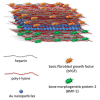The Role of Growth Factors in Bioactive Coatings
- PMID: 34371775
- PMCID: PMC8309025
- DOI: 10.3390/pharmaceutics13071083
The Role of Growth Factors in Bioactive Coatings
Abstract
With increasing obesity and an ageing population, health complications are also on the rise, such as the need to replace a joint with an artificial one. In both humans and animals, the integration of the implant is crucial, and bioactive coatings play an important role in bone tissue engineering. Since bone tissue engineering is about designing an implant that maximally mimics natural bone and is accepted by the tissue, the search for optimal materials and therapeutic agents and their concentrations is increasing. The incorporation of growth factors (GFs) in a bioactive coating represents a novel approach in bone tissue engineering, in which osteoinduction is enhanced in order to create the optimal conditions for the bone healing process, which crucially affects implant fixation. For the application of GFs in coatings and their implementation in clinical practice, factors such as the choice of one or more GFs, their concentration, the coating material, the method of incorporation, and the implant material must be considered to achieve the desired controlled release. Therefore, the avoidance of revision surgery also depends on the success of the design of the most appropriate bioactive coating. This overview considers the integration of the most common GFs that have been investigated in in vitro and in vivo studies, as well as in human clinical trials, with the aim of applying them in bioactive coatings. An overview of the main therapeutic agents that can stimulate cells to express the GFs necessary for bone tissue development is also provided. The main objective is to present the advantages and disadvantages of the GFs that have shown promise for inclusion in bioactive coatings according to the results of numerous studies.
Keywords: bioactive coating; bone tissue; controlled local release; growth factor; implant; osseointegration.
Conflict of interest statement
The authors declare no conflict of interest.
Figures








Similar articles
-
Bioactive coatings with anti-osteoclast therapeutic agents for bone implants: Enhanced compliance and prolonged implant life.Pharmacol Res. 2022 Feb;176:106060. doi: 10.1016/j.phrs.2022.106060. Epub 2022 Jan 6. Pharmacol Res. 2022. PMID: 34998972 Review.
-
Strontium in the bone-implant interface.Dan Med Bull. 2011 May;58(5):B4286. Dan Med Bull. 2011. PMID: 21535993 Review.
-
Analytical Techniques for the Characterization of Bioactive Coatings for Orthopaedic Implants.Biomedicines. 2021 Dec 17;9(12):1936. doi: 10.3390/biomedicines9121936. Biomedicines. 2021. PMID: 34944750 Free PMC article. Review.
-
Enhanced osseous implant fixation with strontium-substituted bioactive glass coating.Tissue Eng Part A. 2014 Jul;20(13-14):1850-7. doi: 10.1089/ten.TEA.2013.0304. Epub 2014 Mar 7. Tissue Eng Part A. 2014. PMID: 24471799
-
Biofunctional magnesium coating of implant materials by physical vapour deposition.Biomater Transl. 2021 Sep 28;2(3):248-256. doi: 10.12336/biomatertransl.2021.03.007. eCollection 2021. Biomater Transl. 2021. PMID: 35836651 Free PMC article. Review.
Cited by
-
BMP-2 releasing mineral-coated microparticle-integrated hydrogel system for enhanced bone regeneration.Front Bioeng Biotechnol. 2023 Aug 10;11:1217335. doi: 10.3389/fbioe.2023.1217335. eCollection 2023. Front Bioeng Biotechnol. 2023. PMID: 37635994 Free PMC article.
-
Applications of Growth Factors in Implant Dentistry.Curr Issues Mol Biol. 2025 Apr 28;47(5):317. doi: 10.3390/cimb47050317. Curr Issues Mol Biol. 2025. PMID: 40699716 Free PMC article. Review.
-
Quaternized Chitosan/Heparin Polyelectrolyte Multilayer Films for Protein Delivery.Biomacromolecules. 2022 Nov 14;23(11):4734-4748. doi: 10.1021/acs.biomac.2c00926. Epub 2022 Oct 26. Biomacromolecules. 2022. PMID: 36289568 Free PMC article.
-
Functionalized 3D-Printed ST2/Gelatin Methacryloyl/Polcaprolactone Scaffolds for Enhancing Bone Regeneration with Vascularization.Int J Mol Sci. 2022 Jul 28;23(15):8347. doi: 10.3390/ijms23158347. Int J Mol Sci. 2022. PMID: 35955478 Free PMC article.
-
Navigating the combinations of platelet-rich fibrin with biomaterials used in maxillofacial surgery.Front Bioeng Biotechnol. 2024 Oct 7;12:1465019. doi: 10.3389/fbioe.2024.1465019. eCollection 2024. Front Bioeng Biotechnol. 2024. PMID: 39434715 Free PMC article. Review.
References
-
- American Academy of Orthopaedic Surgeons Total Joint Replacement. [(accessed on 3 December 2020)]; Available online: https://orthoinfo.aaos.org/en/treatment/total-joint-replacement/
-
- Bayliss L.E., Culliford D., Monk A.P., Glyn-Jones S., Prieto-Alhambra D., Judge A., Cooper C., Carr A.J., Arden N.K., Beard D.J., et al. The effect of patient age at intervention on risk of implant revision after total replacement of the hip or knee: A population-based cohort study. Lancet. 2017;389:1424–1430. doi: 10.1016/S0140-6736(17)30059-4. - DOI - PMC - PubMed
-
- Evans J.T., Evans J.P., Walker R.W., Blom A.W., Whitehouse M.R., Sayers A. How long does a hip replacement last? A systematic review and meta-analysis of case series and national registry reports with more than 15 years of follow-up. Lancet. 2019;393:647–654. doi: 10.1016/S0140-6736(18)31665-9. - DOI - PMC - PubMed
Publication types
Grants and funding
LinkOut - more resources
Full Text Sources

